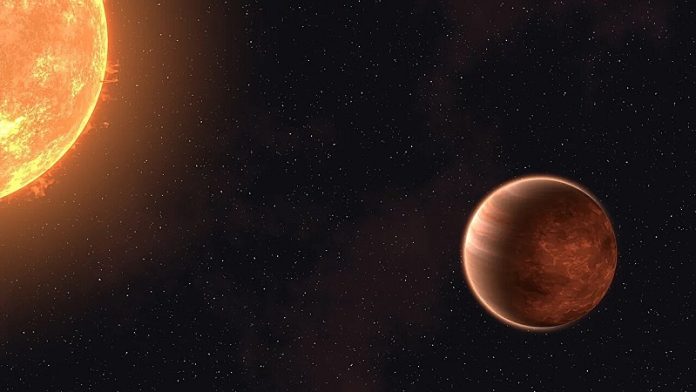
Astronomers have used the James Webb Space Telescope (JWST) to create a detailed temperature map of WASP-43b, a giant gas planet known as a “hot Jupiter” due to its extreme heat and close orbit to its star.
This recent study, which includes contributions from the Max Planck Institute for Astronomy, sheds light on the exotic and extreme conditions of WASP-43b, revealing its harsh climates and dramatic temperature differences.
WASP-43b orbits its star so closely that it completes a full orbit in just 19.5 hours and is always facing the star with the same side.
This unique positioning results in a blistering temperature of about 1250°C (2282°F) on the planet’s dayside, which is constantly exposed to the star. In contrast, the nightside, which never sees the star, cools down to around 600°C (1112°F).
What’s intriguing about this exoplanet is the dramatic weather conditions it experiences.
The heat from the dayside is transported to the cooler nightside by violent winds reaching speeds of nearly 9,000 km/h (about 5,592 mph), faster than any winds seen in our solar system.
This quick shift in temperature allows clouds to form on the nightside, although these are not like any clouds we see on Earth. Due to the high temperatures, these clouds are likely made of liquid rock.
The research, led by Taylor J. Bell of the BAER Institute and NASA Ames Research Center, used JWST’s Mid-Infrared Instrument (MIRI) to measure the temperatures across WASP-43b’s surface.
MIRI works like a giant, contactless infrared thermometer, capturing the infrared light emitted by the planet and translating it into temperature readings.
These findings, published in Nature Astronomy, indicate that the nightside’s cloud cover is substantial, blocking much of the infrared radiation from below, which would usually reveal the surface.
This suggests that the nightside is shrouded in thick clouds high in the atmosphere.
Despite expectations of methane production due to the chemical reactions between hydrogen and carbon monoxide on the cooler nightside, the rapid transportation of heat by fierce winds leaves little time for these reactions to occur.
As a result, methane is scarcely produced, which is a surprising discovery given the conditions.
The study also involved observing the planet’s phase curve, similar to how our moon’s appearance changes through its phases.
This method allowed astronomers to monitor the varying temperatures and atmospheric conditions as different parts of the planet faced the telescope during its orbit.
WASP-43b was discovered in 2011, and it continues to be a subject of fascination due to its extreme characteristics.
Observations like these from the JWST provide a deeper understanding of such distant worlds, offering insights into their atmospheric composition, temperature variations, and potential weather patterns.
The future looks bright for further studies, with plans to use JWST’s Near-Infrared Spectrometer (NIRSpec) to explore the presence of carbon monoxide and refine the understanding of the planet’s atmosphere and cloud dynamics.
This study not only highlights the capabilities of the JWST in studying exoplanets in incredible detail but also expands our knowledge of the wide variety of climates and atmospheric phenomena that exist beyond our solar system, reminding us of the special conditions that prevail on Earth.



